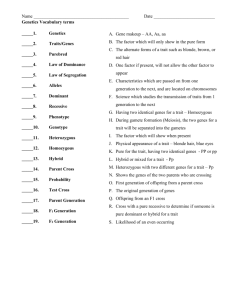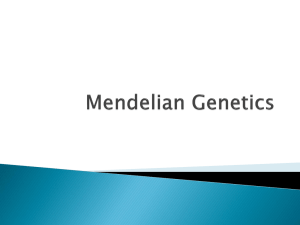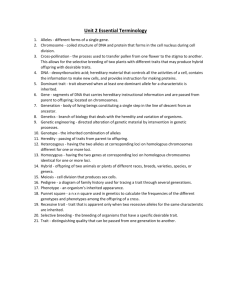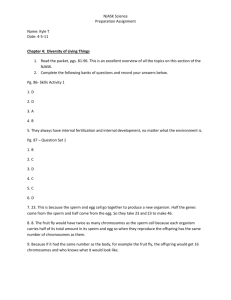Human Traits Lab
advertisement
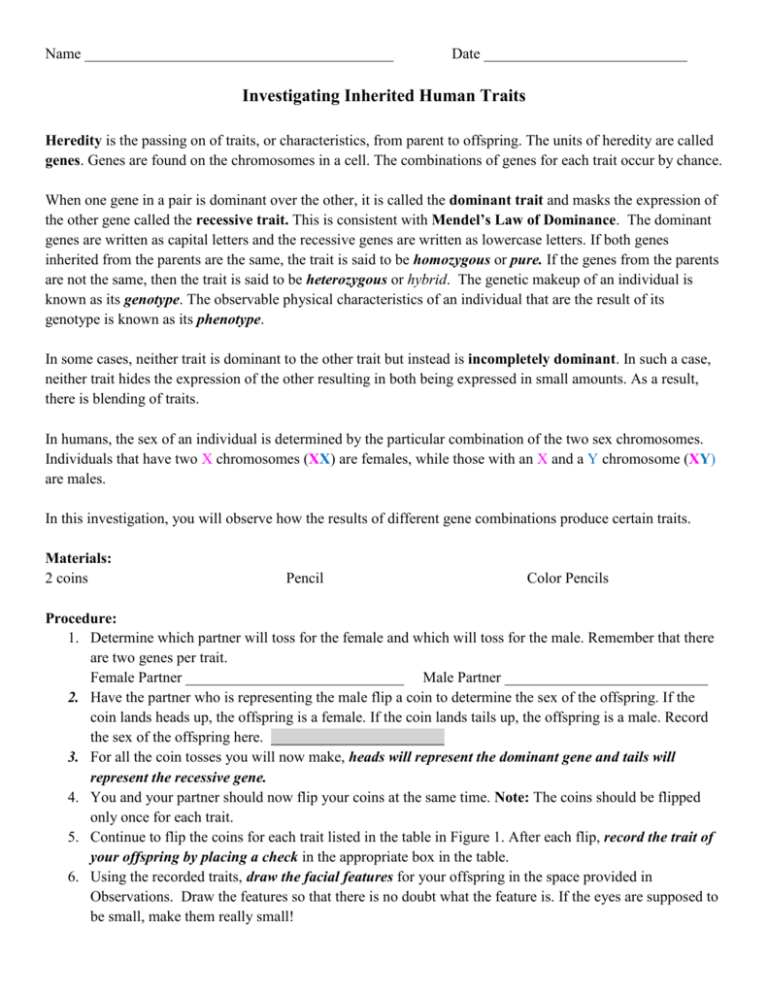
Name _________________________________________ Date ___________________________ Investigating Inherited Human Traits Heredity is the passing on of traits, or characteristics, from parent to offspring. The units of heredity are called genes. Genes are found on the chromosomes in a cell. The combinations of genes for each trait occur by chance. When one gene in a pair is dominant over the other, it is called the dominant trait and masks the expression of the other gene called the recessive trait. This is consistent with Mendel’s Law of Dominance. The dominant genes are written as capital letters and the recessive genes are written as lowercase letters. If both genes inherited from the parents are the same, the trait is said to be homozygous or pure. If the genes from the parents are not the same, then the trait is said to be heterozygous or hybrid. The genetic makeup of an individual is known as its genotype. The observable physical characteristics of an individual that are the result of its genotype is known as its phenotype. In some cases, neither trait is dominant to the other trait but instead is incompletely dominant. In such a case, neither trait hides the expression of the other resulting in both being expressed in small amounts. As a result, there is blending of traits. In humans, the sex of an individual is determined by the particular combination of the two sex chromosomes. Individuals that have two X chromosomes (XX) are females, while those with an X and a Y chromosome (XY) are males. In this investigation, you will observe how the results of different gene combinations produce certain traits. Materials: 2 coins Pencil Color Pencils Procedure: 1. Determine which partner will toss for the female and which will toss for the male. Remember that there are two genes per trait. Female Partner _____________________________ Male Partner ___________________________ 2. Have the partner who is representing the male flip a coin to determine the sex of the offspring. If the coin lands heads up, the offspring is a female. If the coin lands tails up, the offspring is a male. Record the sex of the offspring here. _______________________ 3. For all the coin tosses you will now make, heads will represent the dominant gene and tails will represent the recessive gene. 4. You and your partner should now flip your coins at the same time. Note: The coins should be flipped only once for each trait. 5. Continue to flip the coins for each trait listed in the table in Figure 1. After each flip, record the trait of your offspring by placing a check in the appropriate box in the table. 6. Using the recorded traits, draw the facial features for your offspring in the space provided in Observations. Draw the features so that there is no doubt what the feature is. If the eyes are supposed to be small, make them really small! Analysis and Conclusions: Answer in full, complete sentence. 1. What percent chance did you and your partner have of “producing” a male offspring? ___________% A female offspring? _____________% Explain your answer.__________________________________________________________________ ____________________________________________________________________________________ ____________________________________________________________________________________ 2. Would you expect any other pair of students in your class to have an offspring similar to yours? Explain. ____________________________________________________________________________________ ____________________________________________________________________________________ ____________________________________________________________________________________ 3. Which traits in the investigation were inherited by the blending of genes or incomplete dominant? ____________________________________________________________________________________ ____________________________________________________________________________________ ____________________________________________________________________________________ ____________________________________________________________________________________ 4. What are the possible genotypes of the parents of a child who has wavy hair (Hh)? Show all possibilities ____________________________________________________________________________________ ____________________________________________________________________________________ ____________________________________________________________________________________ 5. Do you think that anyone in your class has all the same genetic traits that you have? Remember that we have ~ 25,000 genes!! Explain your answer ____________________________________________________________________________________ ____________________________________________________________________________________ ____________________________________________________________________________________ ____________________________________________________________________________________ 6. How might it be possible for you to show a trait when neither of your parents shows it? ____________________________________________________________________________________ ____________________________________________________________________________________ ____________________________________________________________________________________ 7. King Henry VII of England divorced his queen and had another beheaded because they produced only daughters. Using your knowledge of genetics, explain why this was an incorrect move on his part. ____________________________________________________________________________________ ____________________________________________________________________________________ ____________________________________________________________________________________ In the box below, draw your lovely child. Remember to over emphasize the features.




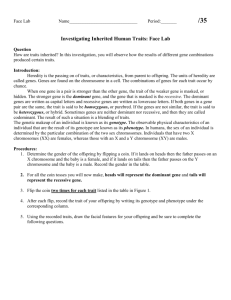
![Biology Chapter 3 Study Guide Heredity [12/10/2015]](http://s3.studylib.net/store/data/006638861_1-0d9e410b8030ad1b7ef4ddd4e479e8f1-300x300.png)
